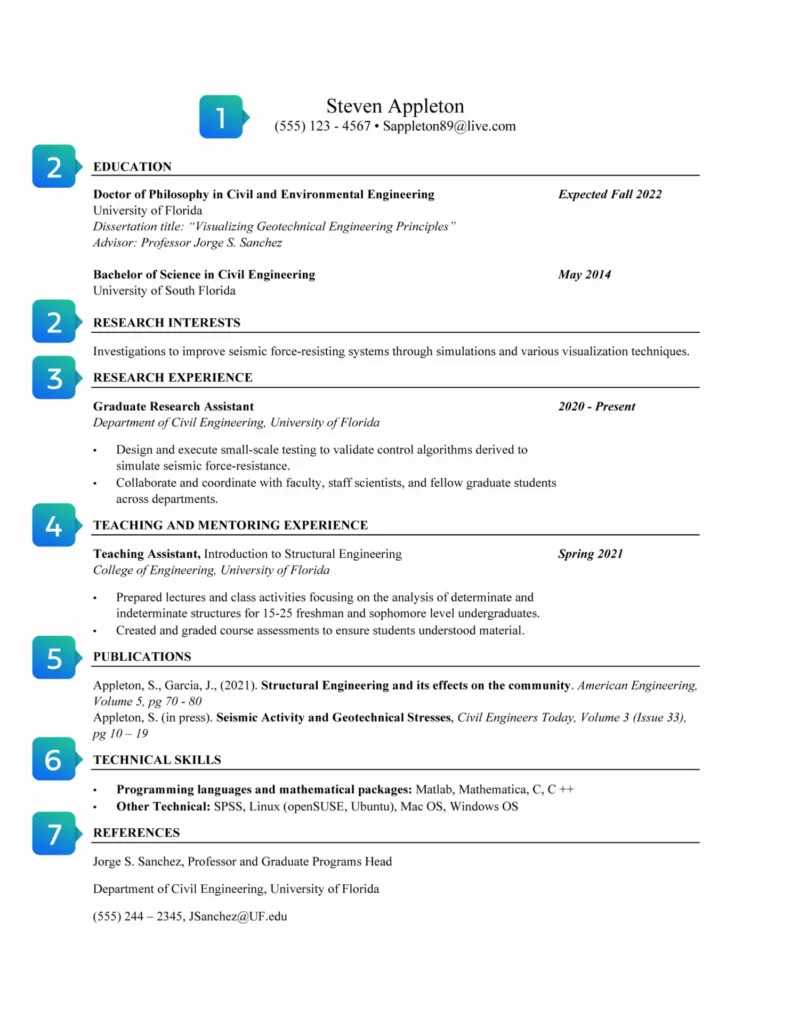What is a CV?
Fun fact: CV is actually short for curriculum vitae, a Latin phrase that literally means ‘course of life.’ In the professional world, a CV is a document that details the full scope of your career and academic accomplishments.
Like a resume, a CV gives background on your skills and work experience. Unlike most resumes though, a CV is typically multiple pages long and includes many more components than a traditional resume. In addition to sections for education and work experience, for example, a CV may also contain sections for awards, research, grants, speaking engagements, publications of your work, and more. Whereas a resume is meant to be a summary of your most relevant qualifications, a CV is a comprehensive breakdown of your professional life to date.
While the resume is the preferred document for most hiring managers in the U.S., a CV may be required in fields like academia or medicine. It’s also the standard job-seeking document in many countries outside the U.S. So if you’re looking for a position abroad, it’s important to understand whats expected in the country where you’re applying.
Who should use a CV?
- Job seekers in fields like academia or medicine
- Candidates applying for grants, research positions, and teaching positions in post-secondary educational institutions
- Professionals in the yachting industry
- People applying for jobs internationally
Who shouldn’t use this type of resume?
- Most job seekers in the U.S.
CV format and key components
CVs adhere to a traditional style and have straightforward formatting. They’re text-based, use conventional fonts, and don’t usually include customized design elements like color or graphics.
The components in a CV will vary between candidates based on their field, type of work, and career objectives. When preparing your CV, you’ll want to arrange the order so that the most relevant sections appear first. If you were applying for research positions, for example, you’d want to lead with your research objectives and related experience.
We’ll go over the sections that are included in our sample CV below, but keep in mind that many additional sections may be added to suit your needs. While this example CV is one page, most CVs are two to three pages or more.
- Contact information
Name, address, phone number, and email are standard. Since CVs are used in fields with more rigid hiring conventions, it’s generally not the norm to include links, like to your website or LinkedIn profile, in a CV. - Education
List every degree, educational institution, and date of attendance in reverse-chronological order. Any degrees you’re currently pursuing should be listed first with an expected date of completion. - Summary
In our example resume, this section is titled ‘Research Interests.’ This is a brief statement that summarizes the types of studies you’re interested in pursuing or the positions you’re seeking. You may also include a few highlights of your professional achievements.
- Experience
Note that in a CV, professional experience is grouped by category (research, teaching, certifications, and so on.) For each item, include the position, the organization, and the dates. Use bullet points to summarize the type of work you completed and your key accomplishments in that role. - Publications
List publications in reverse chronological order. This section should include authoritative work, typically in a peer-reviewed journal, rather than authored pieces in mainstream media outlets or websites. Work that’s pending publishing can also be included. Each publication should be cited in a consistent style, like MLA or AMA. Our example resume uses the following format:[Last name, First initial. (Year of publication). Article title. Journal title, Volume, Page range.] - Skills
List your skills in bullet point form. Relevant certifications can also be included here. - References
It’s more common to see references listed on a CV than on a resume, where it’s generally not advised to include them. In many positions that call for a CV, references are also requested upfront, so it makes sense to list them within the document.
Need help crafting a CV?
Build the perfect CV template to help you get hired faster!
